Conversations about the skilled labor shortage have become commonplace. And though high profile champions, like Mike Rowe, have given new visibility and importance to the looming challenge that threatens all trade professions nationwide, articles typically bemoan the lack of young people entering the trades while offering few solutions. The need for qualified technicians isn’t the Read more
Featured Articles

Conversations about the skilled labor shortage have become commonplace. And though high profile champions, like Mike Rowe, have given new visibility and importance to the looming challenge that threatens all trade professions nationwide, articles typically bemoan the lack of young people entering the trades while offering few solutions.
The need for qualified technicians isn’t the only concern facing the trades, though. Others issues – such as quality of work and the time in which it’s completed – are as much a symptom of the first problem as they are challenges in their own right.
Many proactive, growing companies have squared off with the workforce shortage out of necessity, dealing it blows where they can. This often comes in the form of a bolstered recruiting game, or a train-your-own technician approach.
Local advocacy in high schools helps, too, though positive results come gradually as part of a longer-term effort. And, some companies implement systems and QC measures that help, to a degree at least.
If Baker Group, in Des Moines, IA, wasn’t already a mechanical force to be reckoned with over the past half century, this changed dramatically in early 2017.
Managers within the 650-person design-build firm, already intimately familiar with the advantages of prefabricating plumbing and mechanical systems offsite, made a bold move to expand their manufacturing space by nearly 150 percent. This, they say, has helped to solve several high-level concerns.
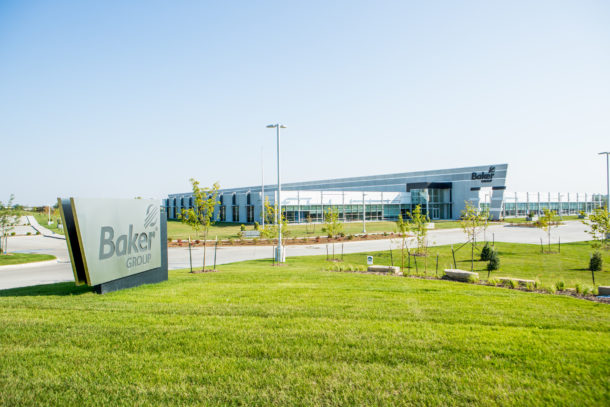
Baker Group is a 650-person, design-build mechanical firm in Des Moines, IA.
Manpower, quality, timeline
The decision to expand was made in order to produce higher quality products, in less time, without creating an unrealistic need for additional skilled manpower.
The firm’s new, 144,000 square-foot facility contains offices as well as manufacturing space, and is called Baker Group Advanced Manufacturing. As many as 75 craftsman can work during a single shift.
“We’ve done prefabrication work since the 1960s,” said Rob Cross, operations manager at Baker Group. “We added a large shop in 1998, and since then, we’ve steadily gained momentum. Our growth necessitated this new expansion last year.”
“The dynamic of the entire construction industry today is built on quality and speed,” says Tom Wengert, VP of Baker Group’s sheet metal business unit. “With this facility, we can prefab systems in a controlled environment, which improves quality while reducing labor costs.
“Additional benefits include increased safety, less congestion on construction sites, less jobsite trash and better scrap material recycling,” added Wengert.
While speed and quality are two major advantages to having a large manufacturing space at your disposal, the efficiency of off-site manufacturing means that fewer employees are needed to accomplish the same task.
Much of the in-shop sequencing implemented by Baker Group at the new facility was adapted from the automotive industry. For example, the flow of materials comes in west side of the shop and leave on the east side.

In 2017, Baker Group expanded their manufacturing space by 150 percent, or 144,000 square feet.
More than sheet metal
Completed in March of 2017, Baker Group Advanced Manufacturing includes 80,000 square-feet of fabrication space with almost 9,000 of that dedicated to multi-trade prefabrication alone.
The multi-trade space is located centrally among the sheet metal, piping and electrical shops. Here, trades work collaboratively in a weather-controlled environment to build to specifications and then ship to the job site.
The space features a 10-ton crane, allowing workers to construct large assemblies. By reducing on-jobsite time, this moves the entire construction timeline forward. The approach increases value to clients, and more than doubles Baker Group’s production capacity.
It’s in this centrally-located, multi-trade space that the various trades come together to assemble systems, sometimes even full mechanical penthouses. Welders work on framing and dunnage while pipefitters connect boilers, chillers, pumps and other equipment. Electricians wire the components and control technicians prepare everything to plug into a BAS.
“A good example of how we build to exact specifications in the shop can be seen in fabrication of gang restroom assemblies,” said Cross. “We can complete an eight-stall bathroom assembly in a little over a day, where it would take nearly a week onsite.”
Welders create an angle-iron framework, perfectly centering all the Watts closet carriers. Once assembled, the system is piped and hydro-tested. Waste water is also tested before the assembly is broken into several pieces for deliver to the job.
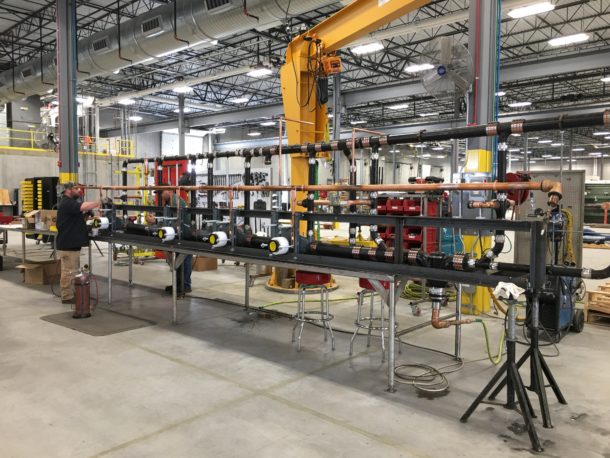
A Baker Group mechanic prefabricates large gang restroom assemblies at the new Advanced Manufacturing facility.
Baker Group has used the Watts back-to-back wall mounted, floor mounted and single closet carrier configurations for a wide variety of projects.
“We’ve standardized on the Watts carriers because the fab crews prefer them and they can be rapidly assembled,” said Cross. The Watts “industry standard closet carriers” come out of the box pre-assembled. The carriers feature a patented compression sealed nipple, which provides fast installation without the need for additional sealants. Adjustment is much easier than when threaded nipples are used.
“We never have any trouble with the closet carriers once they’re in the field, and the support we get from Jeff Howe, at Mack McClain & Associates – our manufacturer’s rep agency – is fantastic,” he continued
Cross has been with Baker Group for 23 years, and the relationship with rep firm Mack McClain goes back as long as he can remember. The firm supplies most of Baker Group’s plumbing components, including toilets, eyewash stations, backflow assemblies, drains and water heaters.
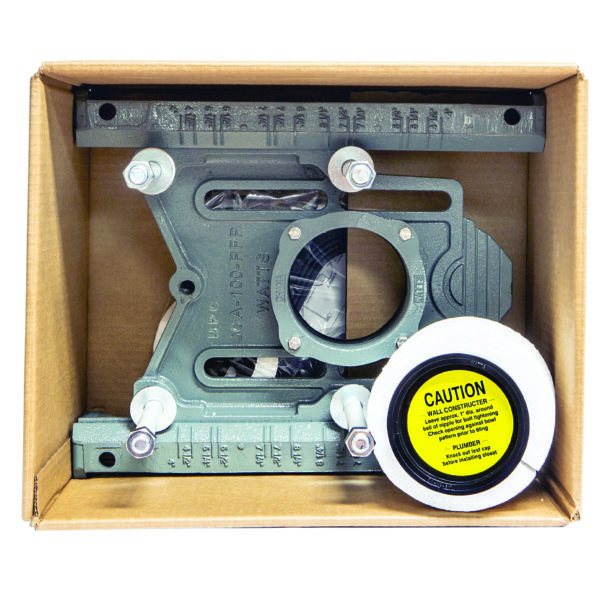
Baker Group has standardized on Watts closet carriers because the fab crews prefer them and they come out of the box pre-assembled.
Still adding capabilities
Toilet carriers aren’t the only plumbing systems that Baker Group prefabricates though. Like their ability to assemble boiler and chiller systems offsite, mechanics also build water service entrances, backflow assemblies, pump skids, pressure reducing stations and water purification systems. Once assembled, these items are broken down only as far as needed to be palletized, and the kits shipped to the jobsite.
“Every year we add something new to what we fabricate here on site,” Cross says, adding that Baker Group’s mechanical capabilities now include fabrication of ASME-rated vessels and components. “We’re equipped with the skills, knowledge, equipment and space to do this intricate and very strict code welding work.”
“Give us your biggest problem; the answer lies within the body of knowledge our people possess. We’ll find the solution,” he continued.
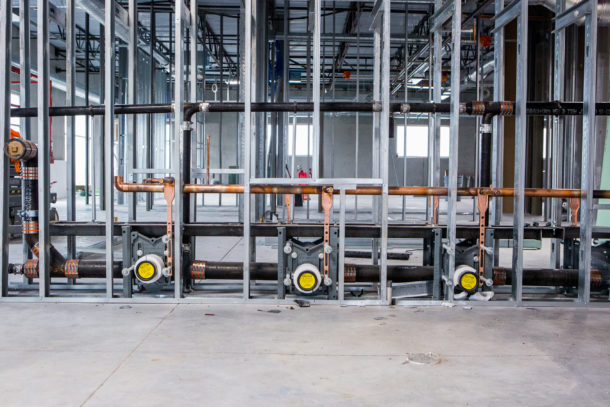
A premanufactured restroom assembly installed onsite.
Filling the new shop
While Baker Group Advanced Manufacturing allows the company to provide more capacity with reduced manpower, the need for new hires to fill the shop still requires ongoing effort.
“We’re a big local advocate for the trades,” said Cross. “We visit high schools and technical schools, invite people to take tours or do job shadowing programs. But we still can’t hire fast enough to fill the need.”
Baker Group is one of the largest, most capable design-build contractors in the Midwest, and they take that title seriously.
The content available on their website and YouTube channel speaks not only to potential clients, but also potential employees.
If the company’s dedication to recruiting parallels their insistence on delivering the best solution on time and on budget, staffing the new shop won’t be an unsurmountable task.

For residential-only contractors, multi-family heating projects have a unique set of challenges. These jobs progress like commercial projects and need to be designed as such. Of course, they’re still residential in nature, but for the most part, it’s commercial work. J.A.M. Plumbing & Heating, Inc. has built an interesting space in the skilled workforce of Read more
For residential-only contractors, multi-family heating projects have a unique set of challenges. These jobs progress like commercial projects and need to be designed as such. Of course, they’re still residential in nature, but for the most part, it’s commercial work.
J.A.M. Plumbing & Heating, Inc. has built an interesting space in the skilled workforce of Rockland County, N.Y. The company is small, when compared to most commercial/industrial contractors in New York. And they’re very good. The owner, Joe Mezzasalma, started the firm in 2003.
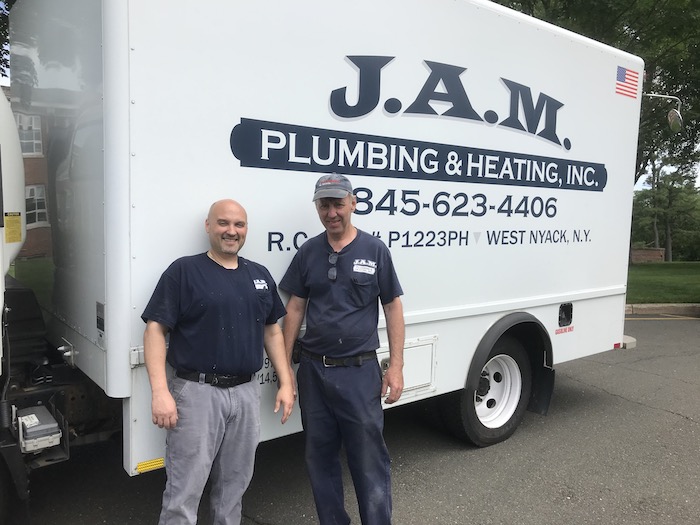
Joe Mezzasalma (left) with Master Plumber John Schauder.
“People don’t hire J.A.M. if they’re simply price shopping,” said Tom Dwyer, at rep firm Venco Sales, who has known Mezzasalma for 12 years. “Joe is a craftsman. People hire him because they know he can make a difference.”
J.A.M. never works outside of Rockland County. In fact, the four-person crew, which includes Mezzasalma, is almost exclusive to five towns; Orangeburg, Sparkill, Tappan, Blauvelt and Piermont. There’s more than enough work without travelling farther.
Multi-family service and replacement
One of J.A.M.’s areas of expertise is multi-family housing. And there’s plenty of it in Rockland County, as far as suburban areas go. Blue Hill Commons is a condominium neighborhood built in the 1970s with 15 buildings. They range in size from four to 12 units per building.
“We’ve done service work at Blue Hill Commons for more than a decade,” said Mezzasalma. “Each year, we assess the health of the boiler systems and, if needed, schedule replacements.”
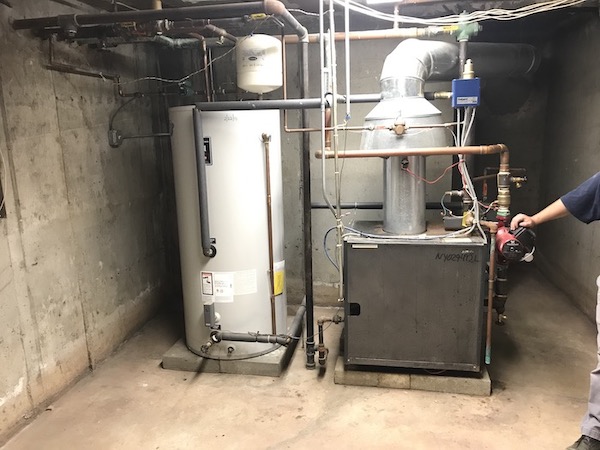
The Blue Hill Commons building #3 mechanical room before J.A.M. conducted a retrofit.
After 30 years in service, the boiler in building #3 was showing its age. The nine-unit condo building was served by a single large boiler and an indirect tank. Fin tube radiation is installed with zone valves on each apartment, one zone per apartment.
“Tom Dwyer visited the job with me in September of 2020,” said Mezzasalma. “He sized and designed the new system. It was his idea to use two boilers instead of one, for efficiency and little redundancy.”
Dwyer’s plan was to install two, 140-MBH X-2 boilers, made by U.S. Boiler Company. Because the budget didn’t have room for condensing boilers, the new system could still have two stages of input by placing the cast iron Series X-2 boilers in a lead-lag-rotate configuration with an external staging control.
Work began in October and was finished in two weeks. Heat wasn’t needed at the time, and DHW was temporarily supplied with an electric water heater.
The hardest part of the job was getting the old boiler out and the new boilers in. The basement mechanical room can only be accessed through a tight stairwell. The existing chimney was used to vent both X-2 boilers, and J.A.M. installed a new indirect water heater.
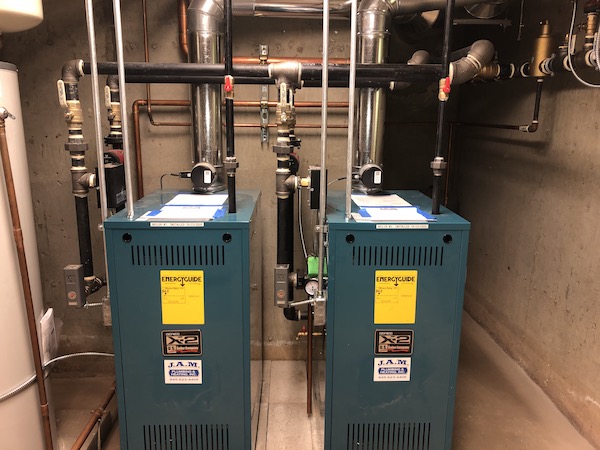
J.A.M. installed two X-2 cast iron boilers, made by U.S. Boiler Company.
“This was out first time I using the X-2, and I’ll use it again,” said Mezzasalma. “It’s everything a cast iron boiler should be; simple yet compact, with easy-to-access controls.” The Series X-2 is available in seven sizes from 70 to 280 MBH. Design of the American-made, cast iron heat exchanger promotes turbulent water flow for efficient heat transfer, providing an impressive 84 percent AFUE.
Because four buildings are tied to the same gas meter, there was no way to quantify gas savings. After one winter in service, and a winter in which many residents stayed home, no complaints came in.
“No news is good news,” said Mezzasalma. “You never get positive feedback, either, so silence is golden. I have to hand it to Tom on the design of this system. He didn’t want to want to replace one large boiler with another single boiler, and I know, whether the gas savings are immediately evident or not, we’ll be saving gas in Building #3.”
Educational work
Shortly before J.A.M started the Blue Hill Commons project, the company was busy with a larger project at St. Thomas Aquinus College (STAC), in Sparkill, NY. College expansion required a new dorm building.
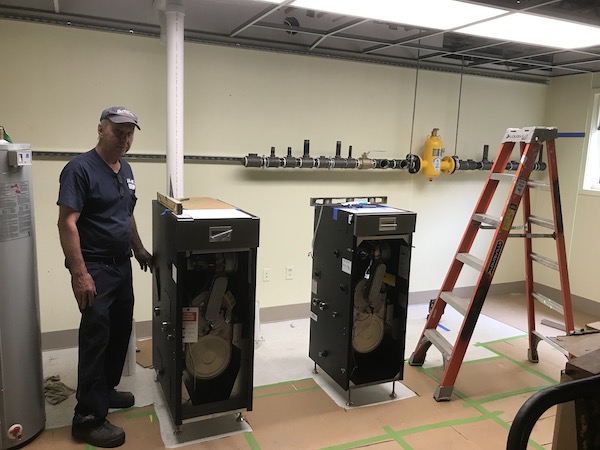
Master Plumber John Schauder assembling a boiler room at St. Thomas Aquinas College, including two large Alpine boilers, made by U.S. Boiler Company.
“We’re on the college’s preferred contractor list, so we got a call when they built the new 36-room dormitory,” said Mezzasalma. “The engineer actually asked us which condensing boiler we preferred to use, and he designed the system around that, U.S. Boiler Company’s Alpine mod-con.”
J.A.M.’s work on the dorm included all plumbing in addition to the hydronic system, which serves the building’s common areas and provides DHW. The two common areas each include a fan coil unit, and individual dorm rooms are heated and cooled with PTAC units.
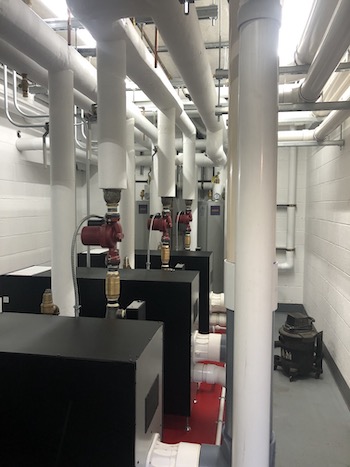
A boiler room with multiple Alpines that J.A.M. previously completed at St. Thomas Aquinas College.
Two, 210-MBH Alpines boilers were installed on the second floor, along with a 34-gallon instantaneous indirect tank.
“Weight was a consideration for everything in the mechanical room, due to its second story location,” explained Mezzasalma. “That’s one reason we installed the Alpine boilers and was also a consideration when the water heater was selected. The Alpine boilers each have a five-to-one firing ratio, so by pairing them, the system effectively has a 10-to-one turndown. The 410 MBH input provides ample capacity to heat the space and create 15 GPM of domestic hot water. After all, there are 36 bathrooms in the building.”
Other than weight, we chose the Alpine because we trust the unit,” he continued. “We’ve installed them in much larger multi-boiler systems before. The controls are great, it’s easy to service, and it’s very efficient.”
The project started in March of 2020 and culminated in August. COVID halted progress entirely at one point, and created scheduling conflicts throughout the project. Weather was an issue too. As luck would have it, heavy rain complicated the outdoor plumbing portion of the job.
Tom Dwyer conducted system start-up before the fall semester began. The building was ready, whether or not students would return, or learn from home.
Today, J.A.M. Plumbing & Heating, Inc. is currently installing two more Alpines at the college and rezoning the Romano Student Center. Stellar craftsmanship, paired with solid product and design support, wins and keeps big customers.

An innovative air conditioning solution from Carrier is helping to ensure optimal ventilation and comfort in the historic Raphael Rooms. During a typical summer, the temperature in Romecan soar as high as 104°F/40°C, making the decision to install air conditioning in the Raphael Rooms for the first time ever an easy one. To meet the Read more
An innovative air conditioning solution from Carrier is helping to ensure optimal ventilation and comfort in the historic Raphael Rooms. During a typical summer, the temperature in Romecan soar as high as 104°F/40°C, making the decision to install air conditioning in the Raphael Rooms for the first time ever an easy one. To meet the unique needs of the historic space, Carrier engineers developed and installed a custom solution utilizing a new system design that delivers heating and cooling in one-quarter of the traditional footprint, all without altering the existing historic infrastructure.

“The Vatican Museums have the mission to ensure the protection and safety of the artwork, spaces and visitors. Carrier was extraordinary because, like its prior work at the Sistine Chapel, the team knew how to work with our technical divisions and how to update these rooms that were not conceived as a museum,” said Barbara Jatta, director, Vatican Museums. “The result not only helps us in our preservation mission for the future generations but also helps in the enjoyment of this heritage frequented daily by numerous visitors, more than 6 million every year.”
“It was a tremendous honor to be asked again by the Vatican Museums to deliver innovative solutions. This project underscores our role as a leader in the industry, who has the expertise to develop unique, customized HVAC solutions,” said Didier Genois, vice president and general manager, Carrier HVAC Europe. “We put our world-class engineering and design resources into this project and are exceptionally proud of the outcome.”
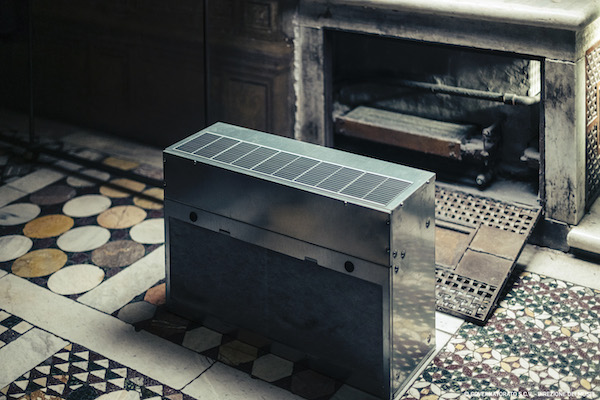
The right solution for the space had to be installed without impacting any of the historic elements within the rooms but would still function to deliver proper ventilation and maintain comfortable temperatures. The Vatican Museums again turned to Carrier, who in 2014 installed an innovative HVAC system at the Sistine Chapel. Carrier engineers specifically designed small, yet high-capacity, fan coils to circulate the air, which were installed underneath the windows in the Raphael Rooms, remaining invisible to visitors. Energy-efficient Carrier AquaSnap 30RQV chillers were also installed in a location unnoticeable to visitors, and an iVu building automation system is now in place to help optimize the HVAC systems to deliver a healthier, safer, and more efficient indoor environment for visitors.
“The space available for equipment inside the Raphael Rooms was very reduced. We had to design a small 2.5 kW fan coil but with 10 kW of capacity, a powerful piece of equipment. This solution is unique because this type of product did not exist. We had to imagine and develop a product that would fit this function in a reduced space,” said Michel Grabon, director, Carrier AdvanTEC/Building Solutions Group Europe.
For more information on Carrier’s customized solutions, visit www.carrier.com.

It doesn’t seem so long ago we were fending off the “green” movement that was being force-fed into the vocab of working contractors. From green building to green technology, greenwashing was so prevalent that really the only “green” contractors were concerned with was the one they were chasing every day—a profit. But alas, a new Read more
It doesn’t seem so long ago we were fending off the “green” movement that was being force-fed into the vocab of working contractors. From green building to green technology, greenwashing was so prevalent that really the only “green” contractors were concerned with was the one they were chasing every day—a profit.
But alas, a new word has dominated the marketing lexicon—“smart.” Smart cars, smart phones, smart homes and yes, even smart pumps. “The problem is they’re not that smart,” says John Barba, contractor training manager, Taco Comfort Systems. “I’ve heard people who you’d think would know better say idiotic stuff like ‘these pumps do the thinking for you,’ and ‘they take the thinking out of it,’” says Barba.

Image Credit: Noven; Bethesda.net
How about giving credit to the users who actually interact with such devices? “The thing that separates the professional from the DIY’er or the handyman is his or her ability to think and their understanding of systems. That’s why people hire professionals, and that’s why our profession is so valuable. When it comes to systems and components, the professional is the smart one,” says Barba
“The professional knows what he’s holding in his hands, why he’s using it and what impact it’s going to have on the overall system performance. There’s not a pump made that can replace what the pro knows. The machines haven’t taken over yet,” continues Barba.
Intelligent Systems
If the integration or connectivity of disparate components to a holistic, communicative system is considered smart, then I’m buying in. Why not just say that in the first place? Because it’s not market-y, and it’s too long for a tagline. Okay, then the evolution of homebuilding can be categorized as being smart or intelligent because the integration of, say, lighting, security, home entertainment, etc., can be accessed from the convenience of your smart phone (more on that later). But I’d say that is more a matter or convenience than smarts.
In fact, as part of these communicative devices, perhaps on a broader, commercial stage, we are witnessing new phrases popping up such as the Internet of Things (IoT). According to Sokwoo Rhee, former associate director of the Cyber-Physical Systems Program at the National Institute of Standards and Technology (NIST) from 2014 to 2021, IoT can be described as the advancements in sensors and communication technologies that enable us to collect data which was not previously practical; the explosive increase of the amount of collected data enabled us to perform analytics which was not previously practical or meaningful; and the advancements in data analytics that will enable us to better control and optimize the systems to benefit our daily life. Again, I can buy into that.
Remember when cell phones were labeled smart phones? I think they still are. It’s 2007 and my fancy handheld device can make calls and perform functions as a computer. Well guess what? Today, they are just considered phones. And, if they don’t perform almost any function you can think of, well, then perhaps they are just dumb.
And, oh yeah, what makes a smart car? Good gas mileage? Actually, the term Smart Car came from a venture between watchmaker Swatch and Mercedes-Benz, with Smart standing for Swatch Mercedes Art, a branding stroke of genius. Its small stature was designed for city driving with big gas savings and easy maneuverability, with not-so-good safety ratings, I’d imagine. Debuting in the U.S. in 2008, last I read, it was discontinued in 2019.
And back to those smart, magical pumps? “The only word I hate more than ‘smart’ is ‘magic,’” says Barba. “Anyone who says something like that really doesn’t know how ECM circulators really work, or how they interact with systems. No matter how ‘smart’ people claim these things are, you can’t get away from the fundamentals of circulators. These things have performance—or ‘control’ curves—and the system still has a system curve,” says Barba.

According to Barba, there’s no such thing as magic, and the only circulator that can even come remotely close to sizing itself is the Taco VT2218—it’s a Delta-T circulator and varies its speed to maintain a fixed delta-T in the system.
“And I don’t care how many lights and buttons you put on the circulator, you can’t change the fact that when you have a fixed performance curve—as every Delta-P variable speed circulator has—the system has to work where the system curve intersects the control curve. If it’s a zone valve system, speed and flow will change as zone valves open and close, but it still works on the selected control curve. If it’s a zone pump system, a Delta-P circulator won’t vary its speed because there’s nothing in a zone that would create a change in pressure differential. It goes one speed and that’s it. That’s not what I’d call smart.
“Now, that doesn’t mean you shouldn’t use a Delta-P pump as a zone pump. You should—it’ll do some pretty cool things for you provided it’s set up properly. And for that, you need a smart installer who understands what these circulators do, what they don’t do and how they interact with the system,” says Barba.
“Just because a circulator is variable speed, that doesn’t make it magic. This isn’t Hogwarts and you’re not Harry-freaking-Potter.”
What’s my point in all of this? Dig deeper, educate yourself, rely on your experience and knowledge, and don’t rely on marketing taglines such as Smart or Green to sell you completely on something.
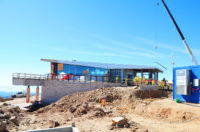
14,000-foot-elevation project uses ProPress The challenge of simply breathing at 14,000 feet in elevation, where the air is exceptionally thin, is tough enough. But add in the manual work done on a construction site, plus weather and Covid-19 precautions, and you’ve got a pretty challenging jobsite. This is exactly what crews from Olson Plumbing and Read more
14,000-foot-elevation project uses ProPress
The challenge of simply breathing at 14,000 feet in elevation, where the air is exceptionally thin, is tough enough. But add in the manual work done on a construction site, plus weather and Covid-19 precautions, and you’ve got a pretty challenging jobsite.
This is exactly what crews from Olson Plumbing and Heating dealt with on a recent project, the Pikes Peak Summit Complex, situated at 14,110 feet in elevation. Crew members who worked atop Pikes Peak in Colorado – at the highest ongoing construction site in North America – had to pass full physicals, were equipped with personal oxygen cans and watched each other closely.
“Any given day, you can almost guarantee that somebody on one of the crews – whether ours or someone else’s up there – would get altitude sickness,” said Dom Wilson, Field Foreman for Olson Plumbing and Heating. “We worked in the buddy system so you could recognize if your partner was not feeling well. What you think is a slight headache is really an attack of the altitude, and you need to get down to 11,000 feet and be evaluated by an EMT.”
The brand-new Summit Complex will replace the Summit House, built more than 60 years ago, and at 38,000 square feet, there was a lot involved with the new build. For contractors who had the ability, prefabrication of anything possible at a lower elevation was all but a necessity.
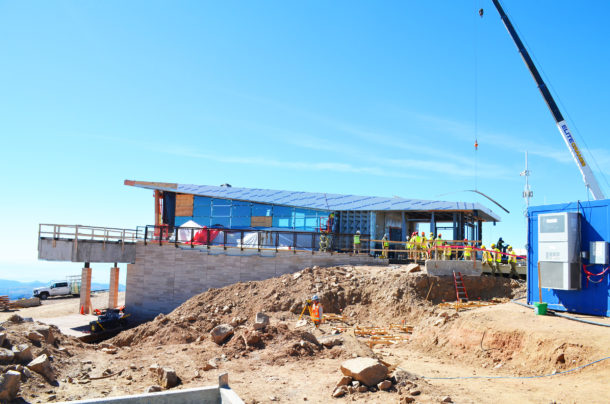
Enter Viega ProPress
The folks at Olson will tell you they use ProPress as often as possible, but using it on a job like the one, for “America’s Mountain,” was extra important. The ability to prefab so many of the pieces at their shop in Colorado Springs, and truck them up the mountain so there was less work to do at altitude, made perfect sense.
“We prefabbed all the domestic and hydronic piping, as much as we could, to minimize labor at the top,” said Josh Crippen, Superintendent at Olson. “We prefabbed our pump skids, all the water heater and boiler skids, all the waste and vent piping. As much as possible.”
Sections of pipe were then trucked up the mountain on special trailers purchased by the general contractor, GE Johnson Construction Company. Crippen said the trailers had movable axles to get through the switchbacks on the steep road to the top.
But before Olson could even think about putting together sections of pipe using ProPress, they first had to pass special specifications. The Summit Complex was constructed to meet The Living Building Challenge, which is one of the most rigorous proven performance standards for buildings.
Certain products are not accepted by the LBC, so there is a strenuous submittal process that Olson and the other subcontractors had to adhere to. Viega certifies many of its products, including ProPress, to the stringent LBC requirements.
Unique construction conditions
Work on the new Summit Complex began in 2018 when existing central utility plants were demolished and a temporary utility plant for blackwater was installed to keep the old Summit House operational during construction of the new building, about 100 feet away.
“Midsummer was a big race to get all of the in-floor heat in and get the foundation done and the building footprint excavated,” said Crippen. “We were really close – three weeks before the weather shut us down.
Regular Colorado weather, which can fluctuate from 30 to 70 degrees in a day, pales in comparison to the weather at the top of a fourteener (what Coloradans call the state’s 58 peaks that are 14,000 feet or higher) like Pikes Peak. While the temperature in Colorado Springs near the base of the mountain might be 30 degrees and sunny, the summit temperature is likely to be –20 degrees with howling winds and nothing to stop them.
And with such treacherous weather conditions, crews working at the summit had to always be on their toes. Crippen described spring and summer lightning storms as “unbelievable” and noted that if there’s lightning within 20 miles, everyone has to shelter in place to stay safe.
The added curveball of Covid-19 safety restrictions made things even more complicated. The logistics of getting everyone up the mountain safely, with vehicle capacities and mask requirements, was tough.
It was time for plumbing and piping in the summer of 2020, so that’s when the crews with Olson really got to work on-site. With a short window to get everything to the peak and in place, the clock was always ticking in the background.
Viega’s role
For the wastewater treatment facility at the summit, Viega ProPress Stainless connects the settling tanks and reclaimed water system. Blackwater is captured, treated through a chlorine UV light filter process and then – after about a year – the graywater can be reused to flush the toilets in the Summit Complex.
“This is not like your average gravity system for drainage!” said Crippen. “It’s a vacuum system like in an airplane or cruise ship. It’s part of the LBC and the green building, to be able to reuse materials. This build will be the first of its kind.”
There are settling tanks at the peak. Solids are pumped out to a truck (through copper with ProPress fittings) and taken down the mountain. The rest goes into other settling tanks where the treatment process begins.
Inside the Summit Complex are 37 water closets and 18 hand sinks. All of the bathroom facilities are serviced through copper with ProPress fittings. The entire building is heated from two electric boilers with 12 zones of in-floor heat, and the heating water is also supplied via ProPress.
The building has three sump pits to handle what Mother Nature provides, and that runoff water is pumped out through copper and ProPress as well.
Each year more than half a million people visit the summit of Pikes Peak. The new three-story Summit Complex will feature a large walkway as well as multimedia exhibits to tell the story and history of the mountain. These indoor and outdoor exhibits will also educate visitors about the climate and geography, recreational opportunities and conservation initiatives – like those of the LBC.
Final construction work was being completed at the Summit Complex in early 2021, with an anticipated open date of early summer 2021.
